84 F. high temperature in the Twin Cities Wednesday.
73 F. average high on May 27.
73 F. high on May 27, 2014.
May 27, 1930: Great Empire Builder Tornado. A direct hit derailed famous train in Norman County.

It Only Takes One
I live in a state of perpetual paranoia. Are the kids safe and healthy? Is my wife upset? What about accounts receivable and payroll? And is this the year an EF-5 tornado hits a downtown? In 2010 Minnesota experienced a mind-blowing 145 tornadoes. Since then it’s been fairly quiet.
We’re going on 10 years since a major Category 3 or stronger hurricane hit the U.S. coastline. Odds favor fewer hurricanes in 2015 with a strong El Nino, but all it takes is one.
Meteorologists worry about apathy setting in – technology has lulled us into a false sense of security. “I can wait until the last moment to evacuate inland or run for the basement!” Were residents of Houston and Austin expecting historic flooding? Probably not.
A low-grade case of weather-paranoia is always a good thing.
Yesterday’s light-switch summer day was a tonic for the soul. Expect more 80s today, a few growls of thunder Friday; then a a cooler, drier, sunnier weekend with highs in the 60s. Only the brave and foolish will be in the lake.
The mercury brushes 80F again next week as dew points top 60. Men will sweat, women will glow, dogs will pant. Summer the way it was probably meant to be at this latitude.
Just make it a habit of keeping a watchful eye on the western sky – OK?
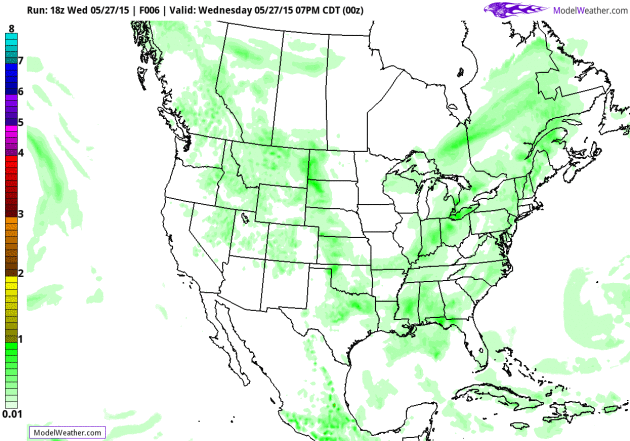
Northward Shift to Monsoon Season? GFS guidance shows a potential for some 3-6″ rainfall amounts from eastern Nebraska into Iowa and southwestern Minnesota by Thursday of next week. With any luck we won’t have a whiplash-event similar to Texas and Oklahoma, but I suspect within a few weeks we won’t be including Drought Monitor maps. Will it be as wet as previous Junes? Possible, but I doubt it. GFS accumulated rainfall forecast: NOAA and AerisWeather.

30 Day Rainfall Departures. NOAA data shows rainfall amounts now as much as 10-15″ above average for the last 30 days over much of Oklahoma and Texas, with pockets of unusually wet soil into Denver and central South Dakota. Meanwhile the east is abnormally dry, and so is the coastal Pacific Northwest.
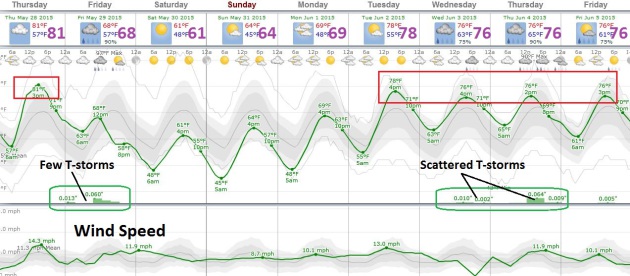
A Sunnier Weekend. Yes, you can have all the sunshine you want Saturday and Sunday, but it will come with a cost. You may not feel inspired to go jump in a lake this weekend with temperatures in the 50s and 60s and a stiff breeze. A drop in humidity will be welcome, along with a lack of red blobs on Doppler radar. I think European guidance (above) is too cool; we should top 80F again next week.
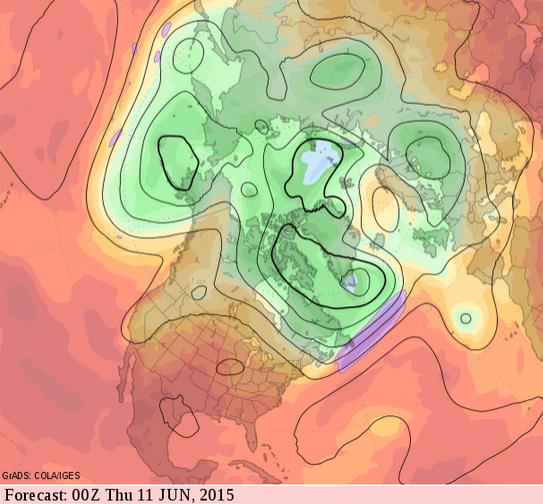
June Heatwave? This is still 2 weeks out and confidence levels are moderate to low, but GFS guidance (500 mb forecast winds aloft) show a big ridge of hot, high pressure forming over the central Plains, the main storm track pushing north into Canada. Will this verify? Will we enjoy a few 90s by mid-June. Check back often, a few dozen times a day would be helpful. Source: GrADS:COLA/IGES.
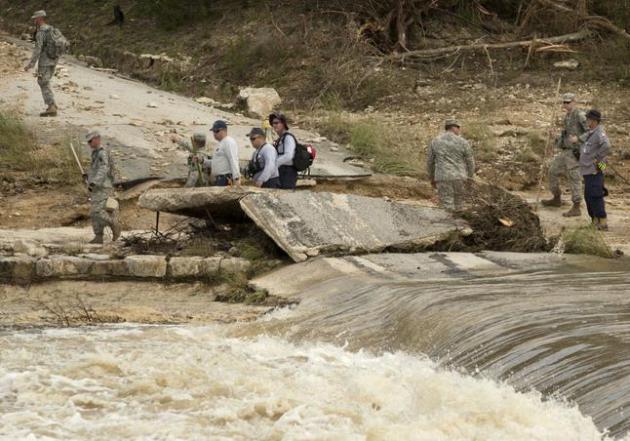
Texas Storms: Flooding Had “Tsunami-Type Power”, Says Governor. The power of moving water: 6″ can knock you off your feet, as little as 2 feet of rapidly moving water can turn your SUV into a boat, with tragic consequences. Here’s an excerpt from The Guardian, including mention of the fact that this is now the wettest May in Oklahoma history: “…Texas governor Greg Abbott has expanded the emergency disaster zone in his state, adding 24 counties to a list of 13 affected by storms and flooding. Three people were reported dead and 12 missing as Oklahoma was also hit hard, while a tornado left 13 dead in a Mexican town just beyond the border. Abbott said the damage caused by flash floods in central Texas was “absolutely devastating” and had been caused by “relentless, tsunami-type power”…”
Photo credit above: “Texas National Guard soldiers and members of the Texas Task Force 1 search for bodies on the banks of the Blanco River after the flood in Wimberley, Texas, on Tuesday May 26, 2015.” (Jay Janner/Austin American-Statesman/TNS)

Texas Was In A Horrible Drought Last Year. Now It’s Flooded. What Gives? Houston saw 1 inch of rain in 5 minutes? Meteorologist Eric Holthaus puts things into perspective at Slate; here’s an excerpt: “…A steadily escalating whipsaw between drought and flood is one of the most confident predictions of an atmosphere with enhanced evaporation rates—meaning, global warming. Since 1958, there’s been a 16 percent increase in the amount of rain falling in the heaviest rainstorms on the Plains, even as long-term projections point toward an increased risk of megadrought. Both of these can happen at the same time...”

Weather-Whiplash: Texas Goes From Extreme Drought to Floods in 3 Weeks. Meteorologist Andrew Freedman takes a look at how what’s happening in Texas fits recent trends; an excerpt of a story at Mashable: “…Murphy says that in Texas, the drought of record, before the more recent one that just ended, occurred in the 1950s. A series of storms in 1957 brought that drought to an abrupt end in much the same way that the current rains are doing, although today’s deluges are more severe in some instances than what took place then. Many climate studies have found that as the world warms in response to rising levels of manmade greenhouse gases, heavy precipitation events are getting more frequent and intense. This is true in the South Central states, but it’s most pronounced in the Northeast and Midwest…”
Photo credit above: “The cement stilts of the home belonging to the Carey family of Corpus Christi, Texas, are all that remain the home was swept away by the Blanco River early Sunday morning during a flash flood in Wimberley, Texas, on Monday, May 25, 2015. The Carey and McComb family, from Corpus Christi, Texas, have been missing since.” (Rodolfo Gonzalez/Austin American-Statesman via AP)

Catastrophic Flooding Sweeps Away Homes, Breaks Records. ThinkProgress has some perspective on the extreme case of weather-whiplash impacting Texas and the southern Plains; here’s an excerpt: “…Going from one extreme to another is a hallmark of climate change. Scientists predict more droughts in the coming decades, as well as more intense rainstorms. In the midwest, the number of storms that drop more than three inches of rain have increased by 50 percent, according to an analysis from the Rocky Mountain Institute. Texas and Oklahoma both face intensifying drought and flooding, although politicians in both states have denied climate change...”
Photo credit above: “With downtown Dallas in view, water from the Trinity River floods the area below the Sylvan Avenue bridge Monday, May 25, 2015, in Dallas. Several people were reported missing in flash flooding from a line of storms that stretched from the Gulf of Mexico to the Great Lakes.” (Louis DeLuca/The Dallas Morning News via AP).

Texas Rains In Keeping With Climate Change. Here’s an excerpt of a statement from The Union of Concerned Scientists: “…Below is a statement by Brenda Ekwurzel, senior climate scientist at the Union of Concerned Scientists. “Around the world, April ocean temperatures have broken records. The Gulf is no exception. The hot Gulf waters combined with a brewing El Nino have contributed to some of the intense precipitation in Texas and beyond. “In addition, because a warmer atmosphere holds more water, climate change means that when it rains it’s more likely to pour. In Texas, the heaviest rainfalls have increased more than 16 percent over the long-term average. This trend will only increase as temperatures rise even more...”
Photo credit above: “A destroyed car is submerged in the Blanco River in Wimberley, Texas, after the flood on Tuesday May 26, 2015.” (Jay Janner/Austin American-Statesman/TNS).
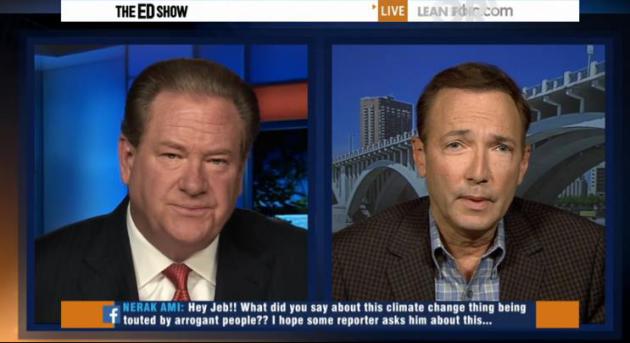
“A Weather and Climate Trifecta”. On Wednesday I had a chance to chat with Ed Schultz on his MSNBC Show (ironic that he was sitting in Detroit Lakes and I was at an uplink facility in Minneapolis) and he asked me to try and put the Texas flooding into context. How much is natural variability vs. thumbprints of climate volatility. The entire 7 minute segment is here.

Scientists Warn To Expect More Weather Extremes. Here’s a clip from a story at The New York Times: “…Yet different parts of the country, and different parts of the country-size state of Texas, can expect different kinds of weather extremes. Severe rainstorms are consistent with the physics of a warming world, with plenty of moisture evaporating off the oceans, Professor Hayhoe noted — especially in the eastern part of the state near the Gulf of Mexico, where things tend to be wet and getting wetter. But the western part of the state is more like the American Southwest, and drier…”

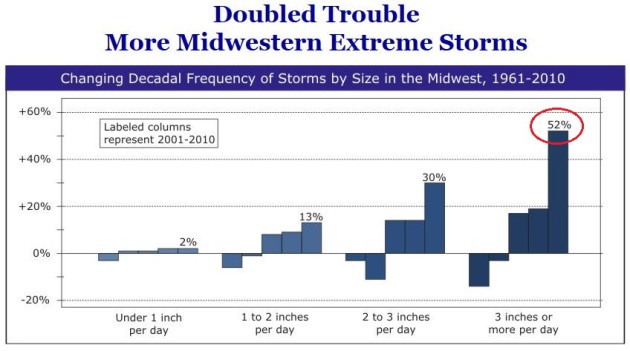
Extreme Rainfall Events On The Rise. It’s not just Texas and Oklahoma, it’s New England, and much of the Upper Midwest. Here’s an excerpt of a story based on research conducted by The Rocky Mountain Climate Organization: “…New RMCO analysis of a half century of precipitation data across the Midwest, defined as Illinois, Indiana, Iowa, Michigan, Minnesota, Missouri, Ohio, and Wisconsin, indicates the region has had an increasing number of large storms since 1961. The largest of storms—those of three inches or more of precipitation in a single day—have increased the most, with their annual frequency more than doubling over the past 51 years. The frequencies of all large storms, especially the largest, have particularly spiked this century…”
Graphic credit above: “Changes in frequencies of storms in the Midwest, by category of storm size for five decades, 1961-1970 through 2001-2010. Labeled changes are for the last decade. Comparisons are to frequencies in 1961-1990.”
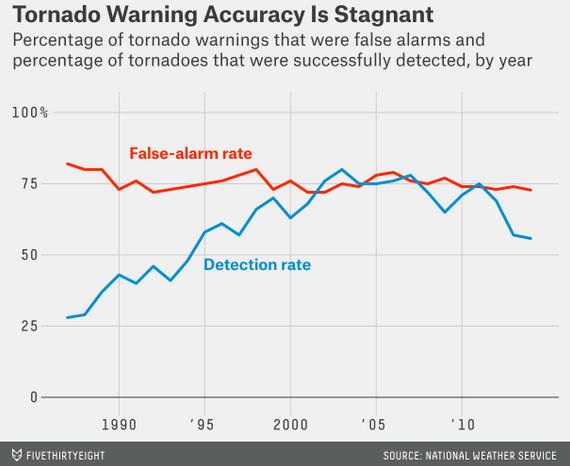
3 Out Of Every 4 Tornado Warnings Are False Alarms. Strongly rotating storms in an environment that’s ripe, primed for tornadoes, is usually enough for a warning to be issued. But only 1 in 4 warnings will produce an actual tornado touchdown – this can lead to resentment, and apathy, when a real tornado does, in fact, materialize. The problems are discussed in a solid article at FiveThirtyEight; here’s an excerpt: “...I think it points to the fact that we still have a long way to go,” said Greg Carbin, a warning coordination meteorologist at the agency’s Storm Prediction Center in Norman, Oklahoma. “You don’t want to miss the bad events. Even in the event where we’re wrong several times, you would rather have a warning out there and have it miss than have an event and not have one out there.” This has been the case for decades. Forecast verification data from the weather service over the past two decades shows that for all the advances technology has provided to forecasting, the agency has made only a relatively small dent in how often it’s wrong when issuing a tornado warning (from 80 percent in 1989 to 72 percent in 2014)...”

Severe Weather May Be Linked To Arctic Warming. More potential evidence that rapid changes in the Arctic may be impacting the speed and configuration of the jet stream, something I’ve been talking about for 15 years. Here’s an excerpt from ScienceDaily: “…They have found that while it is too soon to know for certain whether the Arctic played a role in persistent cold events during the extreme wet UK winter of 2013/14 and recent USA East Coast winters, new studies are adding to the growing weight of evidence linking increased Arctic temperatures with changes in mid-latitude weather patterns. The research published in the Journal of Climate by Professor James Overland of the National Oceanic and Atmospheric Administration (NOAA) and authors from North America, Asia and Europe, including Professor Hanna and Richard Hall, paints a picture of links that vary by region and season...”
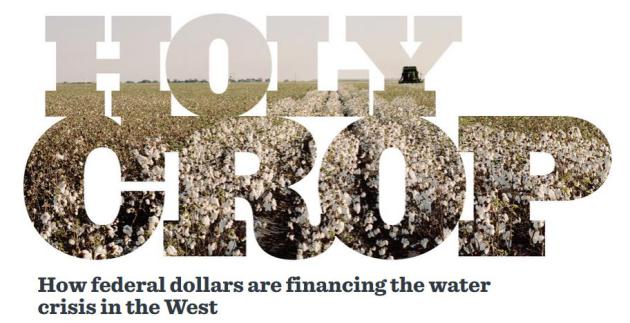
Holy Crop. How Federal Dollars Are Financing The Water Crisis In The West. ProPublica has a long, detailed and vaguely infuriating story about how “incentives” are making the western drought even worse; here’s an excerpt: “…The water shortages that have brought California, Arizona and other Western states to the edge of an environmental cliff have been attributed to a historic climate event — a dry spell that experts worry could be the worst in 1,000 years. But an examination by ProPublica shows that the scarcity of water is as much a man-made crisis as a natural one, the result of decades of missteps and misapprehensions by governments and businesses as they have faced surging demand driven by a booming population. The federal subsidies that prop up cotton farming in Arizona are just one of myriad ways that policymakers have refused, or been slow to reshape laws to reflect the West’s changing circumstances…”

5 Weird Effects of California’s Drought. A few of these from The Sierra Club are non-obvious and sort of counterintuitive; here’s a clip: “We expected lake shrinkage, reduced snowpack, and surfaces more parched than those in anti-aging cream ads. We even saw the almond scapegoating coming. These five ripple effects, however, blindsided us. And most of them are happening right now...”
File Photo credit: “In this April 2, 2015 file photo, Denise Hurst shows her drought-tolerant garden she planted with the help of a city program that offers rebates of $3.50 per square foot for residents who tear up their water-guzzling lawns and plant drought-resistant plants that require little to no watering in Long Beach, Calif.” (AP Photo/Nick Ut, File).

Sleeping With The Seasons: See How Weather Influences Your Sleep. I got a few interesting nuggets of information from this story at Huffington Post; here’s the intro: “Have you ever noticed that different times of year or certain weather patterns influence how you feel or how well you sleep? Though many aspects of achieving good sleep are under our control, one often-overlooked factor is the outside environment. Changes to temperature, atmospheric pressure, humidity and precipitation influence us in many ways, both positive and negative…”
Hospitals are on alert to treat victims of heatstroke and authorities advise people to stay indoors with no end in sight to the searing conditions.
In the worst-hit state of Andhra Pradesh, in the south, 551 people have died in the last week as temperatures hit 47C on Monday.
– See more at: http://www.skynews.com.au/news/top-stories/2015/05/26/india-heatwave-kills-800-as-roads-melt.html#sthash.XKI2zr9B.dpuf

TODAY: Sticky sun, warmer than average. Winds: S 20. High: 83
THURSDAY NIGHT: Chance of a T-storm. Low: 64
FRIDAY: Unsettled. Showers and T-storms likely. High: 72
SATURDAY: Cool sunshine, less humid. Winds: NE 10+ Wake-up: 49. High: 63
SUNDAY: Lots of sun, a bit warmer. Winds: SE 10-15. Wake-up: 48. High: 68
MONDAY: Some sun, isolated T-storm. Wake-up: 53. High: 75
TUESDAY: Warm sun, feeling stickier. Dew point: 61. Wake-up: 61. High: 81
WEDNESDAY: Muggy, scattered T-storms. Wake-up: 63. High: 83
Climate Stories….

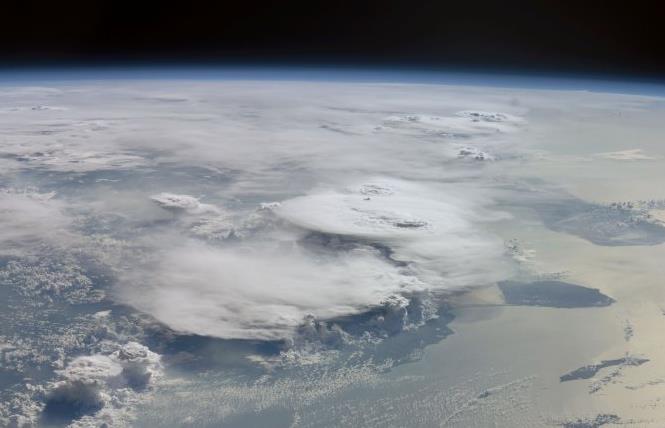



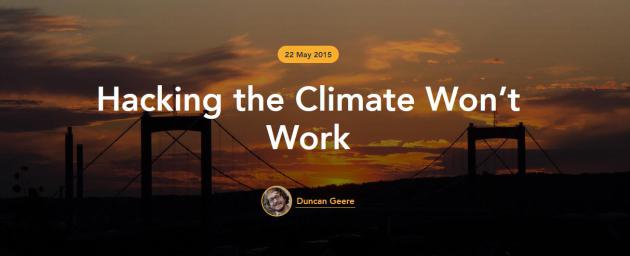
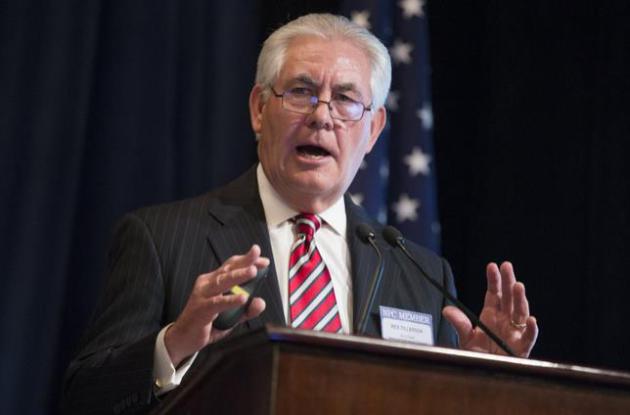
ExxonMobile CEO Mocks Renewable Energy in Shareholder Speech. Here’s a snippet from Politico: “The CEO of one of the world’s largest oil companies downplayed the effects of climate change at his company’s annual meeting Wednesday, telling shareholders his firm hadn’t invested in renewable energy because “We choose not to lose money on purpose.” “Mankind has this enormous capacity to deal with adversity,” ExxonMobil CEO Rex Tillerson told the meeting, pointing to technologies that can combat inclement weather “that may or may not be induced by climate change...”
File photo credit: AP Photo/Evan Vucci.
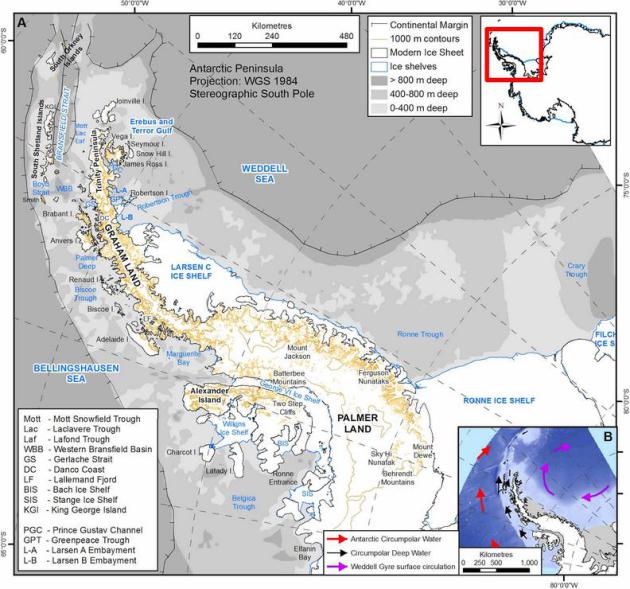
Yet Another Antarctic Ice Mass Is Becoming Destabilized, Scientists Report. Chris Mooney has the details at The Washington Post; here’s an excerpt: “…And the staccato of May melt news isn’t over, it seems. Thursday in Science, researchers from the University of Bristol in Britain, along with researchers from Germany, France and the Netherlands, reported on the retreat of a suite of glaciers farther south from Larsen B and C along the Bellingshausen Sea, in a region known as the Southern Antarctic Peninsula….Using satellite based and gravity measurements, the research team found that “a major portion of the region has, since 2009, destabilized” and accounts for “a major fraction of Antarctica’s contribution to rising sea level...” (Map credit here).
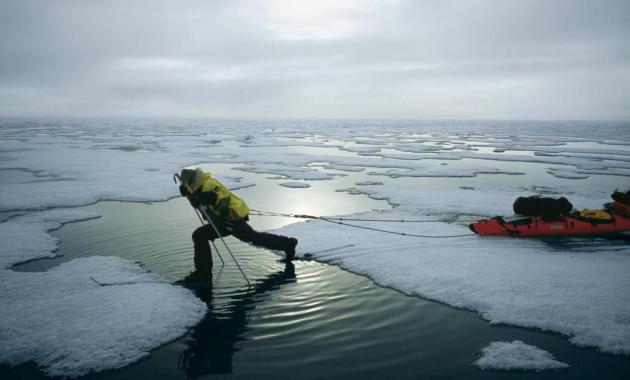
Has The Last Human Trekked To The North Pole? National Geographic takes a look – here’s a snippet of a recent (eye-opening) story: “Faced with a dearth of logistical support and challenges related to climate change, human-powered trips to the North Pole may be on the brink of extinction. “North Pole expeditions are going the way of the passenger pigeon,” says Eric Larsen, a Colorado-based polar explorer who has completed three North Pole expeditions…”
Photo credit above: “Polar explorer Thomas Ulrich skis across a melt pond on sea ice near Champ Island, in Russia’s Franz Josef Land, in 2009. Climate change is making Arctic ice melt faster, making it more perilous to cross.” Photograph by Borge Ousland, National Geographic.

Shell’s CEO Says We Can’t Burn Fossil Fuels in an “Unmitigated Way”. VICE News has more details; here’s a snippet of a recent article: “The CEO of energy giant Royal Dutch Shell has said that the carbon dioxide released by burning fossil fuels must be captured and stored in the ground if the world is going to avoid potentially catastrophic levels of global warming. “We cannot burn all the hydrocarbon resources we have on the planet in an unmitigated way and not expect to have a CO2 loading in the atmosphere that is often being linked to the 2C scenario,” Ben van Beurden, Shell’s chief executive, told the Guardian...”

